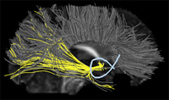

|
|
|
|
| DTI-Query 1.1 | CINCH 1.0 BETA |
In DTI-Query, pathways are selected by interactively specifying "volumes of interest," and finding the pathways that intersect these regions. CINCH takes a different approach - pathway selections are specified using sequences of mouse gestures, which gradually segment the white matter pathways.
In our lab at Stanford, we've found DTI-Query more useful during the initial exploratory stages of an investigation. CINCH has been more useful when the task is known (for example, segmenting a known set of pathways into anatomical groups). CINCH has also been useful for preparing images for publication, since it makes it easy to remove pathways that are clearly the result of tractography errors.
You may want to try them both before you decide.
Download a precompiled
binary for your platform.
-or-
Download the source code and build it yourself.(CINCH source coming soon!)
-or-
Download and build it using a MacPort or FreeBSD port (DTI-Query only).
Preprocess your data.
Learn how to process your data.
Here are some resources for learning DTI-Query and CINCH:
Papers:
Videos:
CINCH video (5 minutes, 29 MB quicktime .mov)